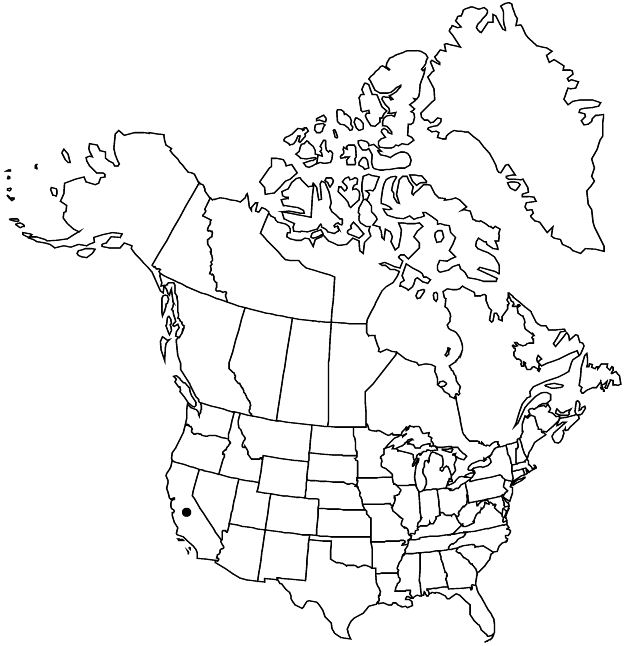Difference between revisions of "Horkelia cuneata"
Edwards’s Bot. Reg. 23: sub plate 1997. 1837.
FNA>Volume Importer |
FNA>Volume Importer |
(No difference)
| |
Revision as of 23:11, 16 December 2019
Plants matted or tufted, green to grayish. Stems decumbent to erect, (1–)2–6(–7.5) dm, hairs ascending to appressed, sometimes spreading. Basal leaves planar, (5–)10–30 × 1.5–4(–5) cm; stipules entire or basally lobed; leaflets 5–12 per side, separate to slightly overlapping, ± elliptic to obovate or oblanceolate, 5–25(–30) × 5–15(–25) mm, ± 1/2 to nearly as wide as long, divided less than 1/3 to midrib into (5–)10–15 oblanceolate to obovate teeth, sparsely pilose to glabrate or sericeous. Cauline leaves 1–3(–5). Inflorescences ± open to congested, flowers arranged individually and/or in glomerules. Pedicels 1–30(–40) mm. Flowers 12–17 mm diam.; epicalyx bractlets lanceolate to ovate, 3–5 × 1.5–3 mm, 2/3–3/4 length of sepals, entire; hypanthium 1.5–2 × 4–7 mm, less than 1/2 as deep as wide, interior glabrous or pilose in a narrow ring; sepals ± reflexed to spreading, lanceolate, 4–6.5 mm; petals oblanceolate to narrowly obovate, 4–8 × 1.5–4 mm, apex obtuse to rounded; filaments 1–3 × 0.5–2 mm, anthers 0.7–1.1 mm; carpels (30–)40–60(–80); styles 2–3 mm. Achenes brown, 1.5–1.8 mm, smooth or minutely rugose.
Discussion
Varieties 3 (3 in the flora).
As noted by D. D. Keck (1938) and B. Ertter (1997b), recognition of subunits within Horkelia cuneata is complicated by the abundance of intermediates, to the extent that a complete transition exists between the decumbent, densely hairy coastal extreme with a congested inflorescence, represented by var. sericea, and the erect, green-glandular interior extreme with an open inflorescence, represented by var. puberula. The traditional division into three infraspecific units is maintained here to emphasize the distinctiveness of the extremes, which would qualify as specifically distinct were they not ends of a continuum. The extremes are furthermore threatened by ongoing decimation of suitable habitats at the northern (San Francisco Bay Area) and southern (greater Los Angeles) ends of the species range.
Determining the correct name of Horkelia cuneata if treated as a species of Potentilla is complicated. Potentilla cuneata (Lindley) Baillon ex Munz & I. M. Johnston (1925) and P. puberula Greene are both later homonyms, while P. multijuga Lehmann has been conserved with a conserved type to maintain established usage for an unrelated species of Potentilla (B. Ertter and J. L. Reveal 2008). J. T. Howell (1945) adopted P. lindleyi; however, as noted by R. F. Hoover (1966), P. kelloggii has priority at species rank by a matter of months. The latter is accordingly the correct name in Potentilla for H. cuneata.
Selected References
None.
Lower Taxa
Key
| 1 | Plants: eglandular hairs sparse or absent, glandular hairs evident; hypanthium interior rim usually glabrous, sometimes sparsely pilose; pedicels (2–)5–10 mm, proximalmost to 40 mm; stems erect. | Horkelia cuneata var. puberula |
| 1 | Plants: eglandular hairs moderately abundant to dense, glandular hairs evident or obscured; hypanthium interior rim ± or densely pilose; pedicels 1–5 mm, proximalmost to 15 mm; stems decumbent to erect | > 2 |
| 2 | Plants ± green, eglandular hairs moderately abundant, spreading to ascending, glandular hairs usually evident; stems ascending to erect. | Horkelia cuneata var. cuneata |
| 2 | Plants grayish-sericeous, eglandular hairs dense, ascending to appressed, glandular hairs obscured; stems decumbent to ascending. | Horkelia cuneata var. sericea |
